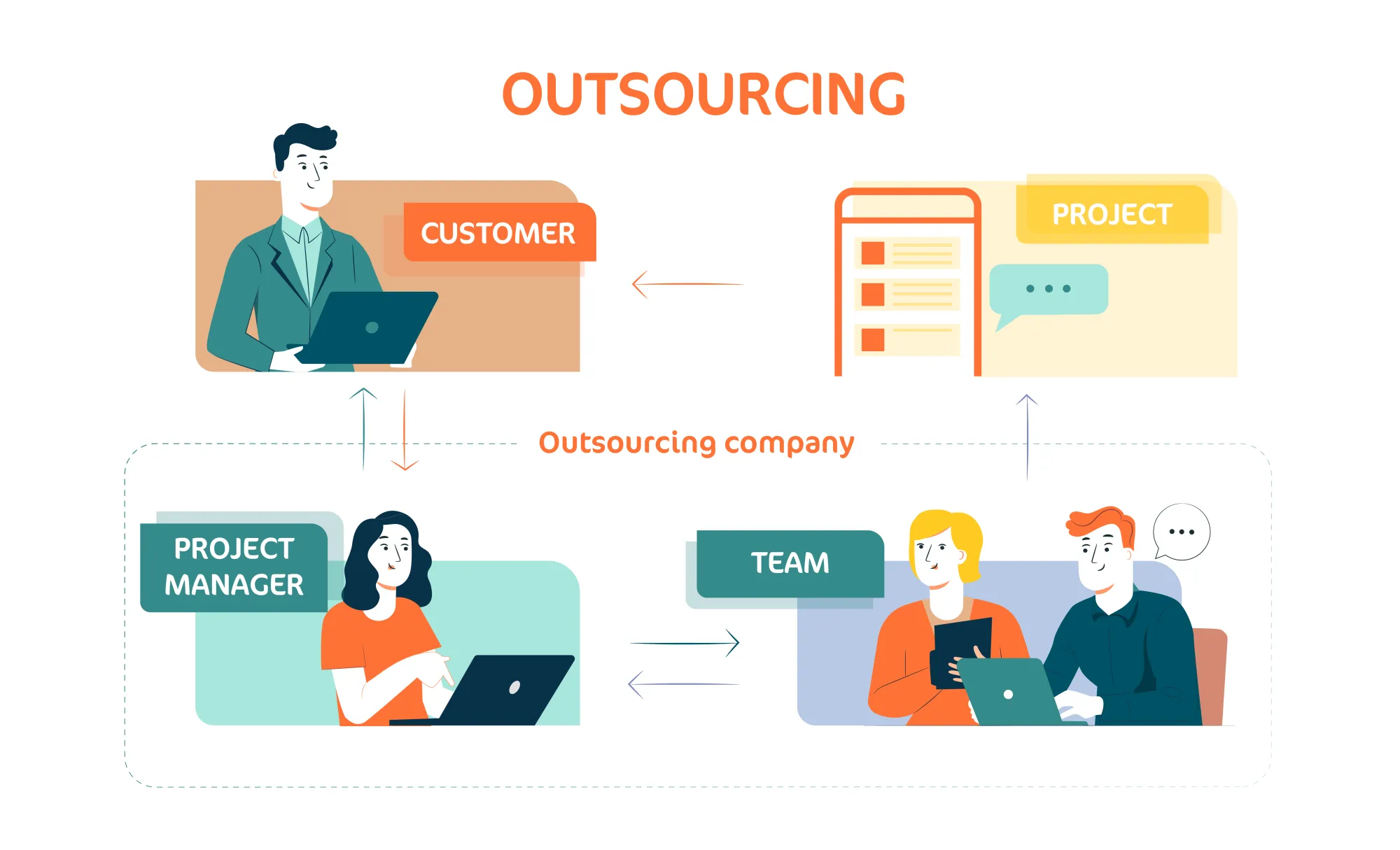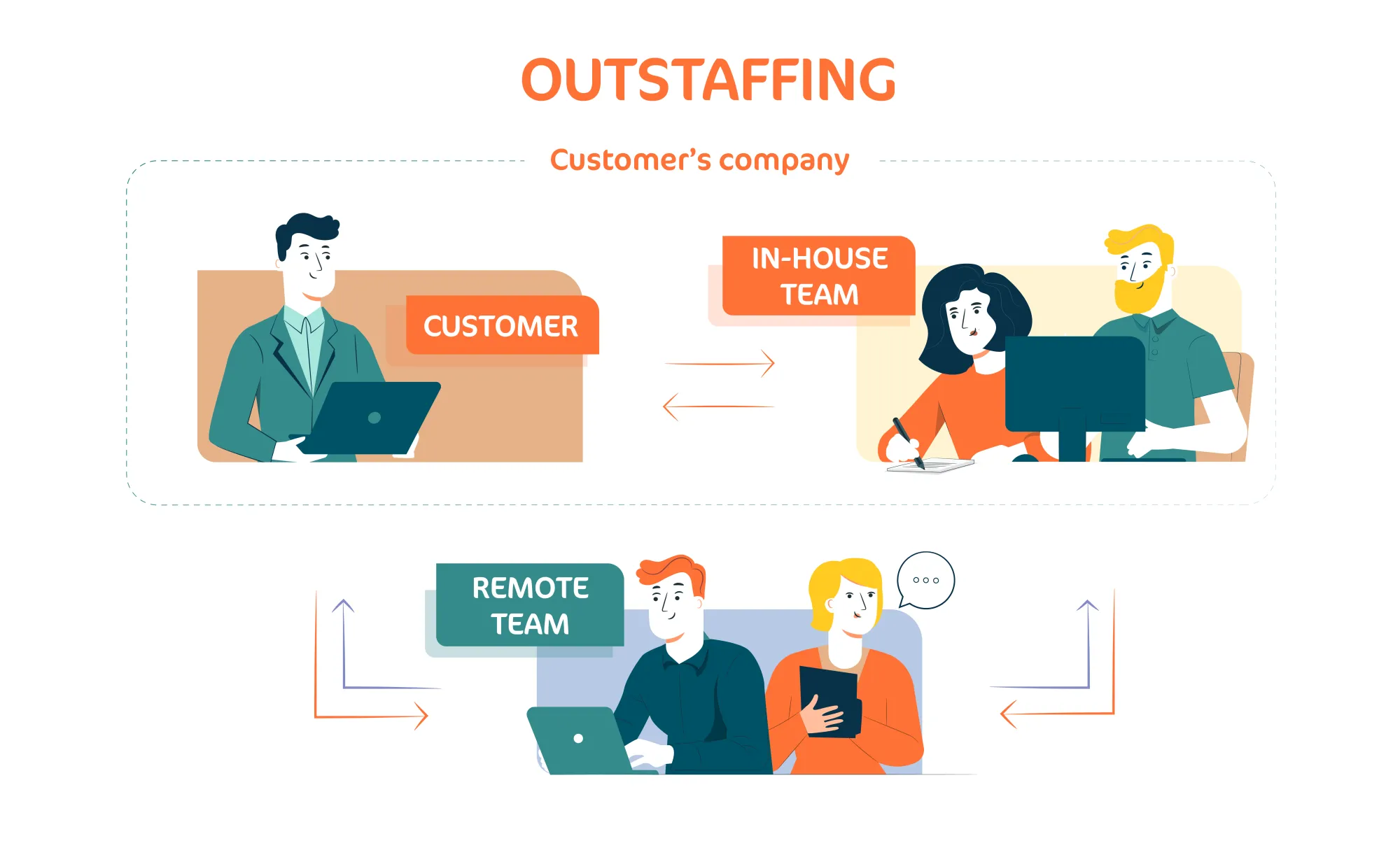How Outsourcing Is Different From Freelance and What Is Outstaffing

The main idea of the terms we are going to look into is saving time and money spent, but most of you also would like to find the answer to the question “which one is better for your case”, so we would also stop to analyze and tip on how to choose will work exactly for you. Let’s dig in and put it all together for a better understanding of the meaning of the outsourcing company.
When a company delegates to other companies to execute certain operations and duties, it is called outsourcing. It was first seen as a cost-cutting and time-saving tool in 1990 but fast enough transformed into a new business strategy. And it has already been three decades of successful implementation of this strategy that allowed and still allows companies to choose the most effective resources with no need to link to a particular location, which also means that outsourcing has a great deal in supporting the global market economy. It has indeed become an inseparable part of all IT businesses in the era of software development.
Every product starts with the idea of the product. When a future client has an idea that requires a programming product, they need to decide, who and how will develop it, and search for the best option of bringing the idea to life. Should they hire specialists to their team or use a contracting out? The second option seems more like an obvious thing to do nowadays. And after the decision-making, the idea creator has to think through the agreement and other routine moments. The following steps usually differ from one entrepreneur to another. However, the actual product starts its way the moment all things are settled and the outsourcing team is ready to launch the project.
Here is the list of IT services that are of the highest demand at the outsourcing market: application support, technical support, infrastructure, software development, web development, database development, telecommunications, and application development.
Most people that are not involved with IT mistakenly assume that developing a software item means just the coding. Of course, coding is the most basic and crucial stage of development, however, the software has to pass a few more important marks on the way to the market even before coding itself, the pre-development step, not mentioning the post-launch support. It is a so-called — Software Development Life Cycle (SDLC), and it customarily consists of the next phases:
- The market analysis.
- Planning.
- Architecture and structuring.
- Design concept-making.
- Coding, testing and debugging.
- Launching.
- Post-launch maintenance.
As any other business project, a non-software release or a marketing campaign software development implies also a few important steps and its life cycle undergoes similar stages during the creation process. If you are not into the IT industry and anything related to programming, you can find yourself lost amidst the whole bulk of specific language that describes the software development process, job titles, and crazy methodologies.
In this guide, we will do our best to explain and simplify the SDLC and its complex and multi-layer structure. Keep scrolling to unlock the Software Development Life Cycle knowledge.
The volume of the project is unessential, to launch the product, one needs the development team for its implementation. The team means that one person can hardly cope with the task assigned to them, no matter how well-trained and professionally skilled the person is. The team is more than one. For the start, you will have to consider including at least these following members:
Project manager
The major task of the project manager is to design and control development standards. They also supervise the production, cultivate the analysis of all the risks and downsides. They are the link between the production crew and the client.
Business analyst
Conducts the business analysis, studies the competitors, assesses the future project, identifies the project phases, and works on the product positioning on the market.
Front-end developer
That is your coder that will write an app and also will carry out debugging, deal with documents for the development process, and will do the post-production support of the product. His scope I the interface, the user-facing side of the software item.
Back-end developer
This developer’s work is based on taking care of the server-side of the item and application architecture, and to integrate them into user interface elements developed by the software engineers.
Mobile developer(s)
Constructs the mobile application that mirrors the website of the programming item. Each of the mobile platforms you wish to operate for the mobile application creation will require their specific mobile developer.
UI/UX designer
When it is time to work on the design of the web product and the application, you will want to use this professional.
QA engineer
This skillful specialist follows up every phase of the development, as well as carries out tests of an app to ensure its proper and stable work.
Before starting any cooperation involving an outsource company, think of a proper way to organize it. Plenty of documents must be done. And you have to think of a model, on which your collaboration will be based.
An engagement model is the set of directions the parties involved in cooperation are obliged to follow. The company should choose between four models that are present in the IT industry, which are:
- Fixed Price or FP model
- Time and Material or T&M model
- Dedicated Team & Cost Plus or Outstaff model
- Investments in Product or Product model
The Fixed Price model is suitable for short-term projects and most frequently used when working with freelancers and subcontractors. The next two models are fit for projects of any length, but with one important difference you should be aware of: T&M model implicates full delegation of the managing function to the client so that all the development is controlled by the outsource company, while the DT model works otherwise and the ordering company holds control and responsibility for the development progress.
The Fixed Price model is suitable for short-term projects and most frequently used when working with freelancers and subcontractors. The next two models are fit for projects of any length, but with one important difference you should be aware of: T&M model implicates full delegation of the managing function to the client so that all the development is controlled by the outsource company, while the DT model works otherwise and the ordering company holds control and responsibility for the development progress.
When the model is settled, one also needs to decide on the region where to look for IT outsourcing. There is a major and common dividing the countries of the potential locations into three groups: onshore, nearshore, and offshore. These zones bear the following descriptions – if you hire an outsourcing company based in your country, it is onshore outsourcing; hiring a company from the neighboring country or at least the one located in the next closest four time zones, is a nearshore outsourcing; and so the offshore outsourcing is when you hire a company based in a country that is far more distant. Also, you will see the difference in quality, speed, prices for software development, and other characteristic features depending on the region and its state of economy and technology.
It is quite common to confuse the terms “outsourcing” with “freelancing”. Though the meanings and effectiveness that these terms imply are entirely different. A single freelancer would hardly be able to build a software product from scratch. The most obvious reason is that software development with all the stages of designing, production, and post-production cannot be covered by a single person. At least not in a reasonable time you would want to have the product ready. Of course, you may be considering hiring a few freelancers, however, be ready to face the drawbacks of this plan due to different approach, vision level of skills, or rather unproved feigning expertise. One should think of a full-cycle software development company when searching for a way to realize its software idea in the most effective and professional manner.
Outsourcing companies are third-party that provide software development services under an outsourcing agreement between two companies where one hires another to be responsible for a planned or existing activity that is or could be done internally, and sometimes involves transferring employees and assets from one firm to another.

The outsourcing companies are armed with a perfectly refined software development plan. This is often a team with clearly defined responsibilities of each member and they all work to ensure the continuous work of a project’s full-cycle. And in this case, clients of outsourcing companies receive numerous advantages, the most attractive, perhaps of which is the fact that you can fully delegate the technical part of the project. And this increases the value of such cooperation in many times, in contrast to the situation when there is a need to carry out routine checks or monitor the work of freelancers. The vendor can engage in running their business, expanding, or dealing with other organizational matters, while his idea is being implemented by professionals. When the planning, development, testing, and maintenance of software performance in the outsourcing company is done well then the scale of the project is not important, the team will cope with any task assigned to them. Undoubtedly, you can choose the level of involvement in the process. You can choose the person in charge of your company, the manager, who will keep in touch with the outsourcing company; someone might consider it as appropriate to participate in the recruitment process for fulfilling your order. You can choose the most comfortable scheme according to which you will monitor the process, but basically, it is not necessary if an expert team takes on the project.
Depending on the project for which the outsourcing company is taken, there is a selection of employees with an appropriate set of skills that will fulfill it, based on the technical requirements of the clients. As usual, outsourcing companies have for years been building teams of developers from personnel experienced in the particular software industry. Carefully review their portfolio and any available information about the management and the team. Analyze the work they performed earlier and using which technical tools they implemented previous projects. For example, if the major part of the company’s portfolio is a web design, it is worth considering whether they are suitable for developing a mobile application. Everything, of course, is very individual. Try to study more about specialists in the company and in which niches they can show his skills especially well before rushing to sign a collaboration agreement.
Another indisputable advantage of outsourcing companies is the level of safety. It is difficult to achieve the same data safety when hiring freelancers. Of course, to maintain informational security, additional agreements and several special documents are signed, but this is a naturally determined time investment, the purpose of which is to legally protect both parties to the contract.
Let’s see closer to the major IT outsourcing pros:
- Outsourcing will inevitably result in business profitability. Ordering outsourcing services can greatly reduce the cost of supporting business processes;
- Focus shifts to more important tasks. The delegation of authority significantly frees up time and energy to strengthen the position of the company or develop a new business course;
- Advanced and proven methodologies. The outsourcing company has an invaluable experience of previous developments and implementations of a certain type of software products, which provides a great opportunity to apply this knowledge to any future project, thereby avoiding specific errors;
- Reliability and stability. Outsourcing companies are legally bound by the contract and, accordingly, the legislative base of their country. This imposes a certain responsibility in the performance of work and provided services;
- Cost saving in case of enterprise growth. Any entrepreneur knows the situation when the course is to expand the business. This always entails additional and often considerable costs for hiring new employees, training them, renting large premises, or arranging new offices. This is inevitable and it pays off over time, but it always hits the budget at first. Outsourcing can significantly reduce all of these costs, while not losing the mobility of the business and the time to get the benefits of growth.
The IT outsourcing cons are: - Risk of non-fulfillment of the non-disclosure agreement. The outsourcing company is bound by the regulation on the commercial secret of the client, as well as applicable legislation. The threat is very small, but the transfer of information is possible following the law;
- Human factor. This, let’s say, is a standard unofficial clause, present at any kind of cooperation, production or trade, or any other activity. There is always a risk of a drop in performance, risk of information leakage, or other small snags at any stage of the work, which depends on the person. Unfortunately, it is almost impossible to control or preempt;
- It is not always convenient to control the process of product development;
- There are situations when the cost of outsourcing may be higher than accounting for employees inside the company;
- No company can be 100% immune to bankruptcy, and this also applies to an outsourcing company. Undoubtedly, this will cause certain problems associated with finding a new outsourcing company and transferring all development materials to them;
- Remoteness. The fact that the outsourcing company can be located at several time zones distance will create difficulties with monitoring the production progress.
But in truth, all risks can be eliminated or minimized by a thorough analysis of the IT outsource services market. It is better to spend more time researching and getting a contract with a well-established company that with all the responsibility, experience and skills will realize your ideas.
And now, we will move on to the next term of the outsourcing matter that you would want to know before making any decisions. We’re talking about Outstaffing and we’d like to explain what are the benefits of it and how can it be helpful for your business.
Outstaffing is a management technology, a form of outsourcing that allows the company to provide business processes with the necessary labor resources, using the services of a third-party organization.

Why companies are increasingly willing to use IT outstaffing:
- There is no way to enlarge the company’s staff base due to different reasons and restrictions.
- There is a necessity to cut the company’s staff base without losing the employees.
- If there is a need to run business in another country without establishing a legal entity there.
- When a company has a project for a certain employee after which, they will be no longer need their services.
- An urgent replacement is required for an employee who leaves an extended vacation.
- The customer intends to reduce the costs of maintaining the staff of the main office and other administrative costs associated with the calculation and payment of wages.
There are two main outstaffing models: leasing staff and temporary staffing. To put it simply, these concepts differ in the period for which outstaffing is required. The first serve for long-term (for a period exceeding three months) contractual relations between the customer and the implementing organization. And the second is applicable in cases where a replacement of an employee is required for a period not exceeding three months, or if there is a small project that needs to be carried out by the outstaffing company, which will take from 1 to 3 months.
IT outstaffing advantages: - Helps reduce payroll and income taxes;
- IT outstaffing reduces the burden on HR managers by reducing the number of company employees;
- It makes it possible to follow the software development process and direct access to any of the outstaff team members, their achievements and progress;
- Allows you to hire highly qualified specialists, while not spending too much for their services, as well as payroll taxes;
- With an outstaffing contract, you get more freedom in terms of hiring employees, regardless of existing restrictions on staff expansion.
There are not so many disadvantages to IT outstaffing. When signing a contract and during the collaboration, the most important thing is mutual feedback. Make sure to immediately establish communication with the implementing team, otherwise, difficulties with execution, accuracy, and delivery simply cannot be avoided.
So if terms like outsourcing and outstaffing still seem identical, we’ll try and see into the individual components of these models of software development collaboration in comparison:
Organization of work
An outsourcing contract means that the specialists you have hired will work on their territory and with a rather flexible schedule. When you have signed the outstaffing contract, be aware that hired employees are to obey your company’s working schedule and usually, on the customer’s territory.
Payment
Under the outsourcing contract, you pay for the delivered product when it is completely developed.Under the outstaffing contract, employees receive a monthly salary.
Interaction with the client
The outsourcing agreement, as usual, comes down to a specific work scheme: the client entrusts a specific project to the outsourcing company.Outstaffing works according to two general client interaction algorithms:
- the customer company hires qualified employees for temporary use from the outstaffer company;
- the client company transfers control over its employees to the outstaffer company, but these specialists continue to perform their usual duties for the client company.
To conclude all said above, there are two options for a company that wishes to hire a remote professional to fulfill certain business goals. If there is a small project you want to be done and you prefer one of few specialists for short-term cooperation with cheaper rates, consider one of the outsourcing models.
If you aim for rather an ambitious project with a big amount of work, ready to sign a contract with a team of professionals with well-organized management, then outstaffing is just for you.
Be it software outsourcing or outstaffing, Ukraine can be a great choice both in terms of quality and the costs involved. Living in the modern world with the continuous development of the IT industry, its diversity, all possible forms, and manifestations, it is difficult to remain knowledgeable in this area, especially to a person without programming experience. It seems that the whole life won’t be enough to review all the IT-service providers, to pay attention to the ranges of their work, the tools used, and to analyze the cases. But when you start to examine the project, dividing the complex whole into small simple components, then it’s much easier to proceed. Focus on the region or specific country that interests you - and you will already discard a good half of inappropriate options. Then filter out a few more components that don't suit you. And then ask the developers a question. We will be happy to provide you with the most comprehensive advice on your project. The dedicated team of SmithySoft® will make things work to meet all your IT needs!


